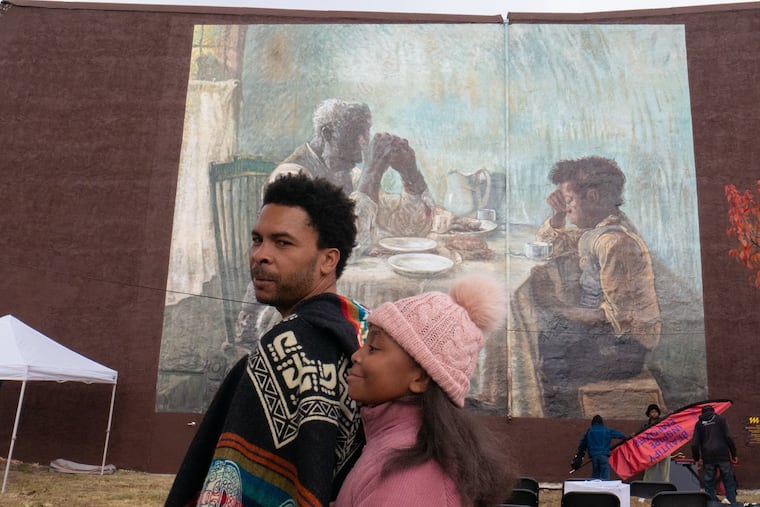Before ‘The Thankful Poor’ mural was dedicated at a Philadelphia church, a child asked: What do the poor have to be thankful for?
Mural Arts held a dedication of the completed The Thankful Poor mural, a recreation of the original painting by Henry Ossawa Tanner. Artist George Anthony Morton was curator of the mural.

George Anthony Morton, the Atlanta artist and subject of the HBO documentary Master of Light, returned to Philadelphia on Sunday for the dedication of a mural of a Henry Ossawa Tanner painting, The Thankful Poor.
The latest Mural Arts creation was installed on a south-facing wall of the Gethsemane FHB Church, at 29th and Dauphin Streets in the Strawberry Mansion neighborhood in North Philadelphia.
It is not far from the Tanner family home, at 2908 W. Diamond St., where Tanner, the first Black American artist to achieve international acclaim, once lived.
In October, Morton visited the Mural Arts studio at the Painted Bride Art Center to work on the mural with local artists Efrain Herrera and Kien Nguyen.
On the mural plaque, Morton is listed as curator and master artist. He studied art while serving a 10-year federal prison term for selling drugs in his 20s.
When he was released, he studied at and graduated from the Florence Academy of Art’s now-closed New Jersey school. In 2017, he was featured in a New York Times article after winning a fellowship to study at the academy’s main campus in Italy.
‘My Light’
At the mural dedication on Sunday, Morton brought his 9-year-old daughter, Nuri, with him.
In introducing him, Mural Arts executive director Jane Golden noted the challenges Morton, who was born in Kansas City, Mo., had faced during his life and how he pushed through them.
“What you do is you bring light and wonder and inspiration to all of us,” she said to him.
As Morton, 41, moved forward to speak, Nuri accompanied him to the podium. He told the small crowd that her name means “my light.”
While he was working on the mural, he said Nuri asked a question that stumped him: “She said, ‘Daddy, why are you painting a painting about being thankful and poor?’ I guess her 9-year-old mind could not reconcile what does a poor person have to be thankful about.
“These are the hard questions that we parents have to deal with often.”
An ‘attitude of gratitude’
He then went on to explain his interpretation of The Thankful Poor:
“I really think that the attitude of gratitude has a lot to do with what this painting is about,” he said. “It has a lot to do with what could produce the resilient spirit of Henry Ossawa Tanner, and the ability to see opportunity where most people see setbacks.”
Tanner, who had moved to Paris to study in 1891, returned to Philadelphia in 1893 to recuperate from an illness. He painted The Banjo Lesson in 1893 and The Thankful Poor in 1894.
“His message of The Thankful Poor is a message of gratitude and reverence at a time when his artistic career was on the ropes,” Morton said. “He was living at the Tanner family home … and recovering from yet another tough illness and unsure where his next breakthrough was to come.”
Morton said Tanner sold both paintings, Thankful Poor and Banjo Lesson, earning enough money to return to Paris to pursue his dreams. He likened Tanner to a “prophet without honor” in his home country.
”And in the forthcoming decade, Tanner would successfully go on to be recognized as the foremost African American artist of his time.”
Tanner’s painting Daniel in the Lion’s Den won an honorable mention in the Paris Salon in 1896. The next year, his The Resurrection of Lazarus was awarded a third-class gold medal at the Salon.
The French government purchased Lazarus for exhibition at the Luxembourg Gallery. It is now at the Musée d’Orsay, Paris.
The Smithsonian American Art Museum noted that Philadelphia merchant Rodman Wanamaker, heir to the Wanamaker department store fortune, was so impressed with Lazarus “that he decided to finance the first of Tanner’s several trips to the Holy Land.”
Morton concluded his remarks on why the poor might be thankful:
“The Thankful Poor serves as a reminder that while being surrounded by the love of one’s family, and deeply rooted in one’s faith, one’s present, unglamorous condition need not be afforded the final word on achieving our ultimate goals and leaving a rich legacy for our future generations.”
Morton also thanked community leader Judith Robinson, who advocated for the mural, and the Friends of the Tanner House for its efforts to preserve the Tanner home.
Philadelphians can see Tanner’s works at the Philadelphia Academy of Fine Arts, where he studied with Thomas Eakins, and at the Philadelphia Museum of Art.
Most of Tanner’s paintings focused on religious themes and the need to flee from persecution. For example, Tanner has painted more than a couple of works called Flight into Egypt.
Art scholars associated those themes with the fact that Tanner’s father, Benjamin Tucker Tanner, was a bishop in the African Methodist Episcopal Church, and his mother, Sarah Elizabeth Miller Tanner, escaped from enslavement in the South as a child.
But it was coincidence that Mural Arts chose the Gethsemane Church for the new Tanner mural, project manager Cathy Harris said. She said Mural Arts had not known of Tanner’s painting The Sleeping Disciples — Christ in the Garden of Gethsemane.